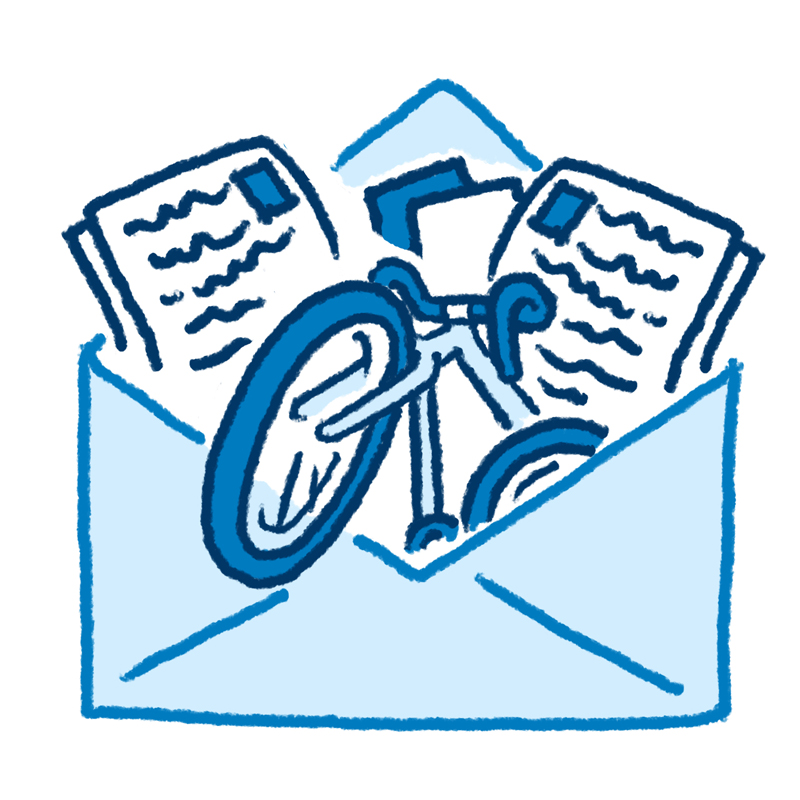Safety Concerns for Bikepackers
Photo by Rob Hamner
Riding a bicycle on backroads and trails is actually, statistically speaking, quite safe. Still, it’s natural to feel anxious about “what ifs” when jumping into something new. The best way to cope with worry is to figure out what’s most likely to go wrong, make sure you’re prepared to deal with it, and then relax and enjoy the ride.
Motor Vehicles
Motor vehicles are statistically the biggest danger to most cyclists, so you can feel good about bikepacking’s focus on quiet backroads and trails. Still, if there’s any chance you’ll meet vehicles on a section of your route, follow the usual safety tips for riding with traffic:
- Wear bright visible clothing.
- Use a flashing tail light and headlight.
- Consider a helmet mirror or handlebar mirror so you’re not surprised by traffic coming up behind you.
- Ride predictably and confidently, follow traffic laws, and signal turns with your arms.
Backcountry Safety
Though trails and backroads are safer from a traffic perspective, they do make it harder to find help if needed. Practice self-reliance with these tips:
- Send a copy of your planned route to a friend or family member
- Carry appropriate clothing and shelter for the weather
- Have a backup navigation system
- Know where water sources are and monitor your water supply
- Ride within your skill limit on difficult terrain, and wear a helmet
- Consider carrying a satellite communication device in places without cell reception, and have a plan for how you’ll use it for both serious and less serious issues.
Using a Satellite Messenger
Satellite devices like SPOT or Garmin InReach send messages via satellite network, so you can communicate even without cell phone service. The emergency “SOS button” goes directly to local search and rescue teams; this is your worst-case-scenario emergency plan in case of life-threatening issues. Many people also use them to send check-in messages, or even automatic location updates at regular intervals, to friends and loved ones.
Animals
Spotting animals in the wild can be a special experience, and most are far more scared of us than we need to be of them. Follow these important tips to keep yourself, your food, and the animals safe:
- If riding in grizzly country, bring bear spray and know how to use it.
- If riding in any kind of bear country, practice bear-safe cooking and food storage.
- Don’t approach or feed any kind of wild animal, even the cute little ones.
- In places with snakes or scorpions, keep an eye out while setting up camp or wandering off-trail, give them a wide berth, and shake out your shoes in the morning.
- Domestic dogs may bark and chase as you pass their territory. You can squirt them with a water bottle, yell in a deep voice, or get off the bike and walk, but reaching the edge of their territory is usually the best way to be free of them.
Personal Safety
Fear of other humans unfortunately looms large for some cyclists. Most people you meet will be friendly and kind, and if you’re riding in less populated areas you won’t meet many people anyway.
- Still, feeling vulnerable really takes the fun out of bikepacking, so it’s worth considering these tips for avoiding trouble and, much more realistically, improving your own peace of mind:
- Choose wild campsites that are not visible from the road and not in the path of passing headlights (avoid the outsides of curves).
- Use common sense when sharing information about your route and camping plans with people you don’t know well.
- Some people carry a self-defense item, like pepper spray or a loud alarm, which can help with peace of mind even though you’ll most likely never use it.
When Fear is Just Fear
Depending on where you ride, the body you live in, and your personal history, you may find that bikepacking brings you face to face with anxieties around safety, especially if you want to ride solo. This is often true for women, who — if you’ll excuse the generalization in order to make a point — are often socially encouraged to feel vulnerable when alone. It’s also true for plenty of other people who feel their appearance or identity make them vulnerable in various ways.
Even folks we tend to think of as exempt from these issues, like physically strong white men, sometimes worry about riding or camping solo despite feeling like they’re not supposed to. We’re all human, and fear is embedded in our deepest wiring.
If you’ve covered the basic safety tips above and still feel apprehensive, here are some tips that might help.
Feeling fear and being in danger are different. Fear is a physiological response that helps us react to danger, but it often gets deployed unnecessarily. When we feel fear thinking about something that hasn’t actually happened, that’s anxiety, and it’s only in our minds. Often fear is just fear, and we are actually perfectly safe.
If your anxiety is related to your gender or identity, seek out examples of other bikepackers who are like you. You’ll find them in Facebook groups, on YouTube, on their own personal websites, and on the Adventure Cyclist blog. No matter who you are, someone you have a lot in common with is out there on their bike having a great time.
You’ll almost certainly feel better after a few positive encounters and uneventful nights. For some people these concerns never go away completely, but they are still able to enjoy bikepacking and learn a lot about their own mind in the process.
That terrifying creature you hear outside your tent at night, creeping closer and closer as your heart pounds in your chest? It’s … a squirrel. Every darn time.
Dealing With Other People’s Fear
Whether you struggle with fear or not, you’ll eventually encounter others who want to do so on your behalf. Perhaps it’s a well-meaning stranger who asks, a few too many times, “Aren’t you afraid?” Maybe it’s loved ones who would prefer that you stay home out of genuine concern for your wellbeing.
Rather than internalizing their worries as your own, realize that these people probably know very little about bikepacking. For loved ones, ease their worries by assuring them you’ve prepared and helping them understand the experience. You might send them links to trip reports from other riders, the Adventure Cycling website, or even this guide. With strangers you might choose to just let their comments go, or use them as an opening for interesting conversation.
Whatever you do, don’t let anyone cause you to second-guess your own capabilities. You’ve researched, prepared, and trained, and you have every right to enjoy your ride with confidence.


